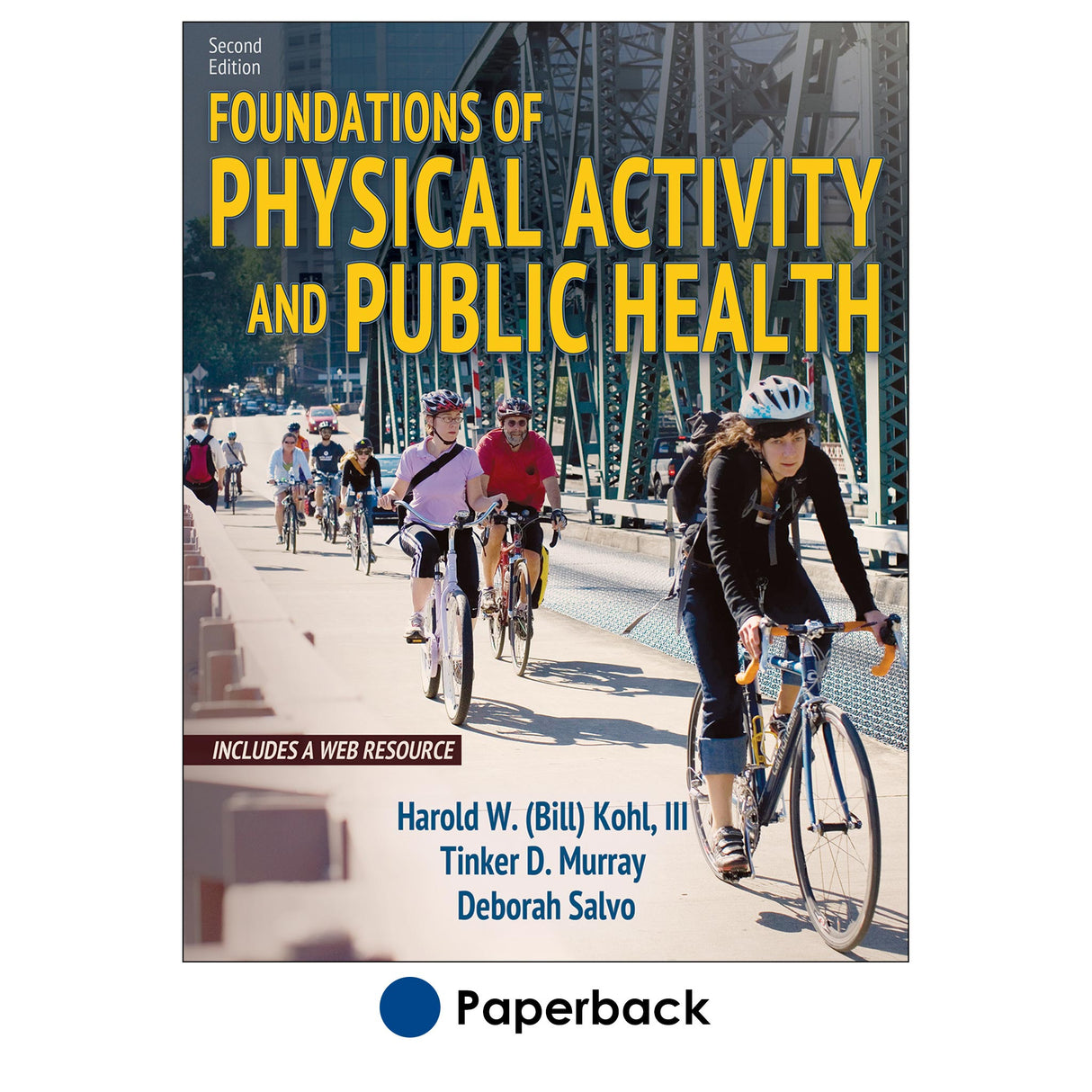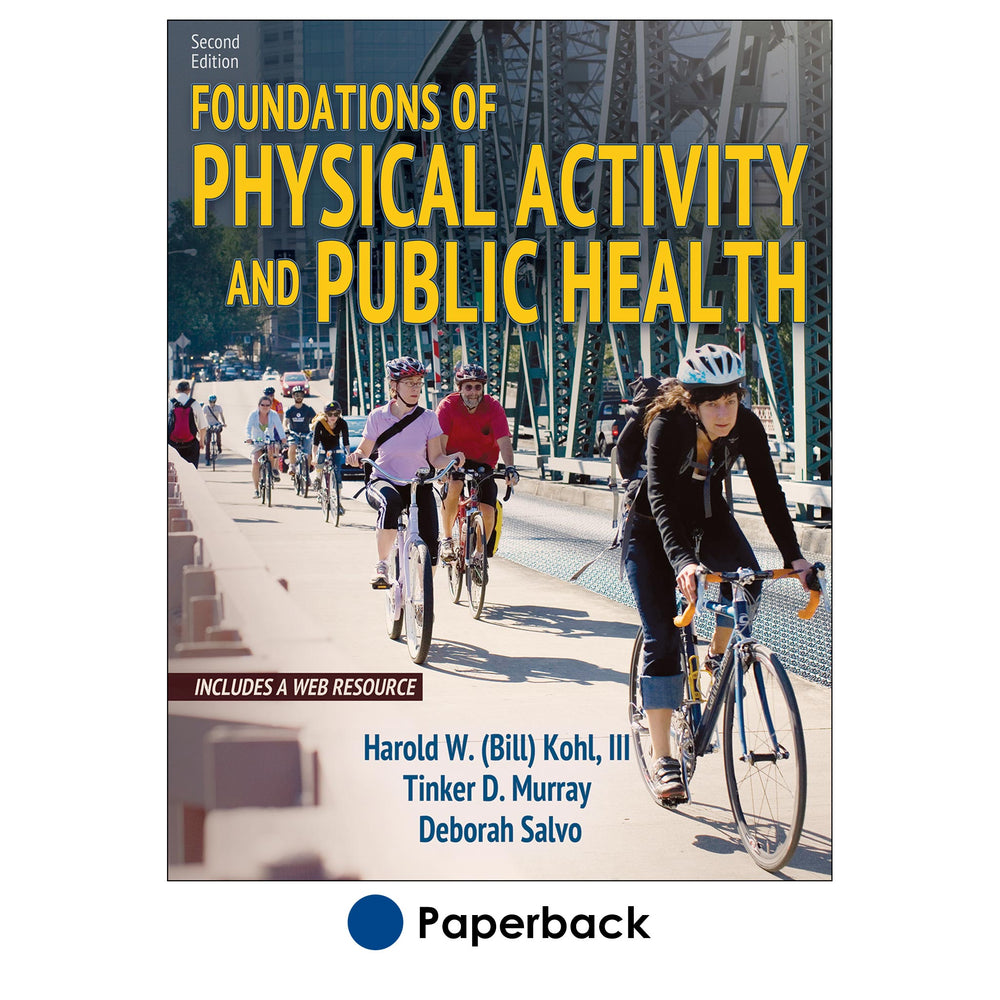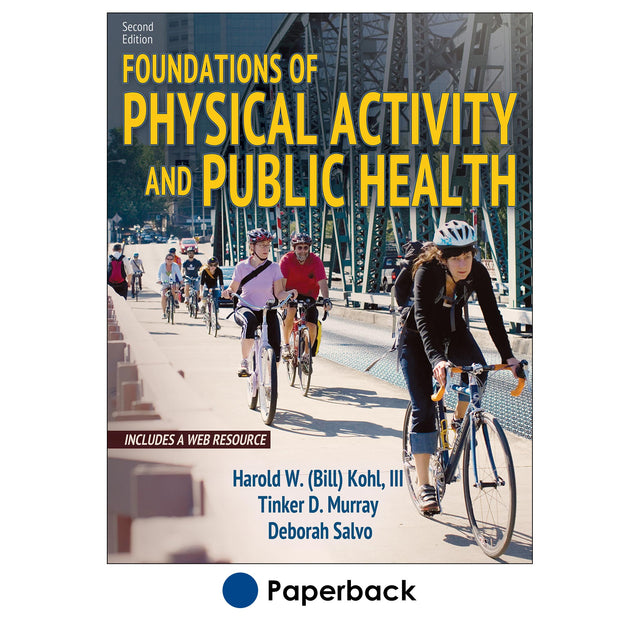Paperback With Online Resource
Foundations of Physical Activity and Public Health 2nd Edition With Web Resource
$49.00 CAD
$166.95 CAD
Unit price
/
Unavailable
Paperback With Online Resource
$49.00 CAD
$49.00 CAD
Paperback With Online Resource
The first textbook to clearly define the intersection of kinesiology and public health, Foundations of Physical Activity and Public Health, Second Edition With Web Resource, has been newly updated to reflect the 2018 Physical Activity Guidelines for Americans issued by the U.S. Department of Health and Human Services. The new edition has been updated with additional contemporary research findings and international examples. With a solid introduction to the concepts of public health and kinesiology, techniques used to measure physical activity, and health effects of exercise and physical activity, the text will show readers how to advance the use of physical activity as a significant component in public health initiatives.
Joining field leaders Harold (Bill) Kohl and Tinker Murray on this second edition is Deborah Salvo, an international expert with a special interest in the relationship between the built environment and health. Other updates to this edition include the following:
To further tie theory to practice, case studies and callout boxes throughout the text provide practical examples, and each chapter ends with a review to solidify student understanding of the material. Leader Profile sidebars allow students to explore career options while learning more about individuals who have had a major impact on this growing field.
As the emphasis on physical activity as a tool for improving public health grows, professionals with combined knowledge and skills from both public health and exercise science fields will be highly sought. Foundations of Physical Activity and Public Health, Second Edition, will help students obtain an overview of kinesiology and public health areas, understand physical activity applications for public health, and learn about career options, and it will inspire them to choose a career and make a difference in the emerging field of physical activity and public health.
Joining field leaders Harold (Bill) Kohl and Tinker Murray on this second edition is Deborah Salvo, an international expert with a special interest in the relationship between the built environment and health. Other updates to this edition include the following:
- New content on the use of electronic devices—such as pedometers and consumer-based wearable technology and apps—for measuring physical activity
- Urban design strategies for promoting physical activity at the community level
- An engaging, full-color visual presentation
- A new web resource that includes key term learning activities and links to the National Physical Activity Society (NPAS) core competencies for public health physical activity practitioners that relate to each chapter
To further tie theory to practice, case studies and callout boxes throughout the text provide practical examples, and each chapter ends with a review to solidify student understanding of the material. Leader Profile sidebars allow students to explore career options while learning more about individuals who have had a major impact on this growing field.
As the emphasis on physical activity as a tool for improving public health grows, professionals with combined knowledge and skills from both public health and exercise science fields will be highly sought. Foundations of Physical Activity and Public Health, Second Edition, will help students obtain an overview of kinesiology and public health areas, understand physical activity applications for public health, and learn about career options, and it will inspire them to choose a career and make a difference in the emerging field of physical activity and public health.
Audience
Textbook for undergraduate and graduate courses in physical activity and public health; reference for public health professionals, health promotion specialists, and exercise scientists interested in physical activity and health. Part I. Introduction to Physical Activity and Public Health
Chapter 1. Fundamentals of Public Health
Defining Moments in Public Health
Areas of Specialization in Public Health
Core Functions of Public Health
Public Health Law
Chapter 2. Fundamentals of Kinesiology
Kinesiology Subdisciplines and Exercise Training
Principles of Exercise Training, Prescription, and Planning
Applying Physical Activity and Exercise Training Principles
Health and Fitness Benefits of Physical Activity and Exercise
Chapter 3. Integrating Public Health and Physical Activity
History of Physical Activity and Public Health
Role of Physical Activity in Chronic Disease Development
From Science to Practice and Back
Promoting Physical Activity for Health
Practitioners of Physical Activity in Public Health
Chapter 4. Measuring Physical Activity
Evidence-Based Recommended Levels of Physical Activity for Health
Laboratory Measures of Energy Expenditure
Electronic Devices to Measure Physical Activity
Direct Observation Techniques
Self-Report Instruments
Surveillance in Populations
Combining Measurement Approaches
Part II. Health Effects of Exercise and Physical Activity
Chapter 5. Cardiorespiratory and Metabolic Health
Prevalence of Cardiovascular Disease
Risk Factors for Cardiovascular Disease
Kinesiology and Cardiorespiratory Health
Cardiorespiratory Fitness Assessments
General Recommendations for Cardiorespiratory Health
Prevalence and Economic Costs of Metabolic Disease
Metabolic Disease Risk Factors
Kinesiology and Metabolic Health
Common Tests of Metabolic Function
General Recommendations for Metabolic Health
Chapter 6. Overweight and Obesity
Caloric Balance
Prevalence of Obesity and Overweight and Associated Health Consequences
Obesity and Overweight Risk Factors
Obesity and Overweight Challenges
Kinesiology and Body Weight
Common Assessments of Obesity and Overweight
Physical Activity Guidelines for a Healthy Weight
Chapter 7. Musculoskeletal and Functional Health
Prevalence of Musculoskeletal Disorders and Related Health Challenges
Risk Factors Associated With Musculoskeletal Disorders and Associated Health Challenges
Kinesiology and Musculoskeletal Health
Common Tests of Musculoskeletal Fitness or Function
Physical Activity and Musculoskeletal Health
Functional Health
Risk Factors for Poor Functional Health
Common Tests of Functional Health
Fitness Recommendations for Functional Health
Chapter 8. Cancers
Prevalence of Cancers
Cancer Risk Factors
Kinesiology and Cancers
Physical Activity Among Cancer Survivors
Physical Activity Guidelines for Cancer Prevention
Chapter 9. Brain Health
Prevalence and Economic Costs of Brain Health Disorders
Common Brain Health Conditions
Risk Factors Associated With Brain Health Disorders
Physical Activity and Brain Health
Physical Activity and Brain Cognitive Function
Physical Activity Guidelines for Brain Health
Chapter 10. Health Risks of Exercise and Physical Activity
Musculoskeletal Injuries
Kinesiology and Musculoskeletal Injuries
Sudden Adverse Cardiac Events
Part III. Strategies for Effective Physical Activity Promotion
Chapter 11. Informational Approaches for Promoting Physical Activity
Understanding the Community Guide
Rationale for Informational Approaches
Chapter 12. School-Based Approaches to Promoting Physical Activity
Rationale for School-Based Physical Activity Programs
Kinesiology and Physical Activity Outcomes for Youth
School-Based Physical Activity and Physical Fitness Assessments of Youth
Physical Activity in Children and Adolescents
International and National Trends in Youth Physical Activity Levels
School-Based Physical Education
Developmental Considerations for Physical Activity in Youth
Chapter 13. Behavioral and Social Approaches to Understanding and Promoting Physical Activity
Behavioral Theories and Theoretical Models of Behavior Change
Social Support for Health Behavior Change
Individually Adapted Health Behavior Change Programs
Socio-Ecological Model of Behavior
Social Support Interventions in Community Settings
Chapter 14. Environmental and Policy Approaches to Promoting Physical Activity
Access
Urban Design
Measuring the Built Environment
Physical Activity Policy
Land Use Policy
Co-Benefits of Activity-Promoting Environments and Policies
Chapter 15. Program and Policy Evaluation for Physical Activity and Public Health
Ways to Measure Program and Policy Effectiveness
Logic Models for Physical Activity Promotion and Policies
Evaluation Designs
Data Collection and Analysis
Publishing and Communicating Results
Chapter 16. Partnership Development and Advocacy
Key Factors in Building Partnerships
Strategies for Physical Activity Advocacy
Chapter 1. Fundamentals of Public Health
Defining Moments in Public Health
Areas of Specialization in Public Health
Core Functions of Public Health
Public Health Law
Chapter 2. Fundamentals of Kinesiology
Kinesiology Subdisciplines and Exercise Training
Principles of Exercise Training, Prescription, and Planning
Applying Physical Activity and Exercise Training Principles
Health and Fitness Benefits of Physical Activity and Exercise
Chapter 3. Integrating Public Health and Physical Activity
History of Physical Activity and Public Health
Role of Physical Activity in Chronic Disease Development
From Science to Practice and Back
Promoting Physical Activity for Health
Practitioners of Physical Activity in Public Health
Chapter 4. Measuring Physical Activity
Evidence-Based Recommended Levels of Physical Activity for Health
Laboratory Measures of Energy Expenditure
Electronic Devices to Measure Physical Activity
Direct Observation Techniques
Self-Report Instruments
Surveillance in Populations
Combining Measurement Approaches
Part II. Health Effects of Exercise and Physical Activity
Chapter 5. Cardiorespiratory and Metabolic Health
Prevalence of Cardiovascular Disease
Risk Factors for Cardiovascular Disease
Kinesiology and Cardiorespiratory Health
Cardiorespiratory Fitness Assessments
General Recommendations for Cardiorespiratory Health
Prevalence and Economic Costs of Metabolic Disease
Metabolic Disease Risk Factors
Kinesiology and Metabolic Health
Common Tests of Metabolic Function
General Recommendations for Metabolic Health
Chapter 6. Overweight and Obesity
Caloric Balance
Prevalence of Obesity and Overweight and Associated Health Consequences
Obesity and Overweight Risk Factors
Obesity and Overweight Challenges
Kinesiology and Body Weight
Common Assessments of Obesity and Overweight
Physical Activity Guidelines for a Healthy Weight
Chapter 7. Musculoskeletal and Functional Health
Prevalence of Musculoskeletal Disorders and Related Health Challenges
Risk Factors Associated With Musculoskeletal Disorders and Associated Health Challenges
Kinesiology and Musculoskeletal Health
Common Tests of Musculoskeletal Fitness or Function
Physical Activity and Musculoskeletal Health
Functional Health
Risk Factors for Poor Functional Health
Common Tests of Functional Health
Fitness Recommendations for Functional Health
Chapter 8. Cancers
Prevalence of Cancers
Cancer Risk Factors
Kinesiology and Cancers
Physical Activity Among Cancer Survivors
Physical Activity Guidelines for Cancer Prevention
Chapter 9. Brain Health
Prevalence and Economic Costs of Brain Health Disorders
Common Brain Health Conditions
Risk Factors Associated With Brain Health Disorders
Physical Activity and Brain Health
Physical Activity and Brain Cognitive Function
Physical Activity Guidelines for Brain Health
Chapter 10. Health Risks of Exercise and Physical Activity
Musculoskeletal Injuries
Kinesiology and Musculoskeletal Injuries
Sudden Adverse Cardiac Events
Part III. Strategies for Effective Physical Activity Promotion
Chapter 11. Informational Approaches for Promoting Physical Activity
Understanding the Community Guide
Rationale for Informational Approaches
Chapter 12. School-Based Approaches to Promoting Physical Activity
Rationale for School-Based Physical Activity Programs
Kinesiology and Physical Activity Outcomes for Youth
School-Based Physical Activity and Physical Fitness Assessments of Youth
Physical Activity in Children and Adolescents
International and National Trends in Youth Physical Activity Levels
School-Based Physical Education
Developmental Considerations for Physical Activity in Youth
Chapter 13. Behavioral and Social Approaches to Understanding and Promoting Physical Activity
Behavioral Theories and Theoretical Models of Behavior Change
Social Support for Health Behavior Change
Individually Adapted Health Behavior Change Programs
Socio-Ecological Model of Behavior
Social Support Interventions in Community Settings
Chapter 14. Environmental and Policy Approaches to Promoting Physical Activity
Access
Urban Design
Measuring the Built Environment
Physical Activity Policy
Land Use Policy
Co-Benefits of Activity-Promoting Environments and Policies
Chapter 15. Program and Policy Evaluation for Physical Activity and Public Health
Ways to Measure Program and Policy Effectiveness
Logic Models for Physical Activity Promotion and Policies
Evaluation Designs
Data Collection and Analysis
Publishing and Communicating Results
Chapter 16. Partnership Development and Advocacy
Key Factors in Building Partnerships
Strategies for Physical Activity Advocacy
All ancillaries are free to adopting instructors and available online.
Instructor guide. Includes teaching strategies, syllabus suggestions, discussion questions, class activities and assignments, and lesson plans.
Test package. This bank of questions includes true-false, fill-in-the-blank, essay and short-answer, and multiple-choice formats. The test package is available for use through multiple formats, including learning management system, Respondus, and rich text.
Presentation package plus image bank. Includes more than 330 PowerPoint slides of text, artwork, and tables from the book that can be used for class discussion and presentation. The slides in the presentation package can be used directly within PowerPoint or printed for distribution to students. Instructors can easily add, modify, and rearrange the order of the slides.
The companion image bank includes most of the figures, images, and tables from the text, sorted by chapter. These can be used in developing a customized presentation based on specific course requirements.
Web resource. Features key term learning activities and weblinks to explore issues related to physical activity, exercise, and public health.
Instructor guide. Includes teaching strategies, syllabus suggestions, discussion questions, class activities and assignments, and lesson plans.
Test package. This bank of questions includes true-false, fill-in-the-blank, essay and short-answer, and multiple-choice formats. The test package is available for use through multiple formats, including learning management system, Respondus, and rich text.
Presentation package plus image bank. Includes more than 330 PowerPoint slides of text, artwork, and tables from the book that can be used for class discussion and presentation. The slides in the presentation package can be used directly within PowerPoint or printed for distribution to students. Instructors can easily add, modify, and rearrange the order of the slides.
The companion image bank includes most of the figures, images, and tables from the text, sorted by chapter. These can be used in developing a customized presentation based on specific course requirements.
Web resource. Features key term learning activities and weblinks to explore issues related to physical activity, exercise, and public health.





